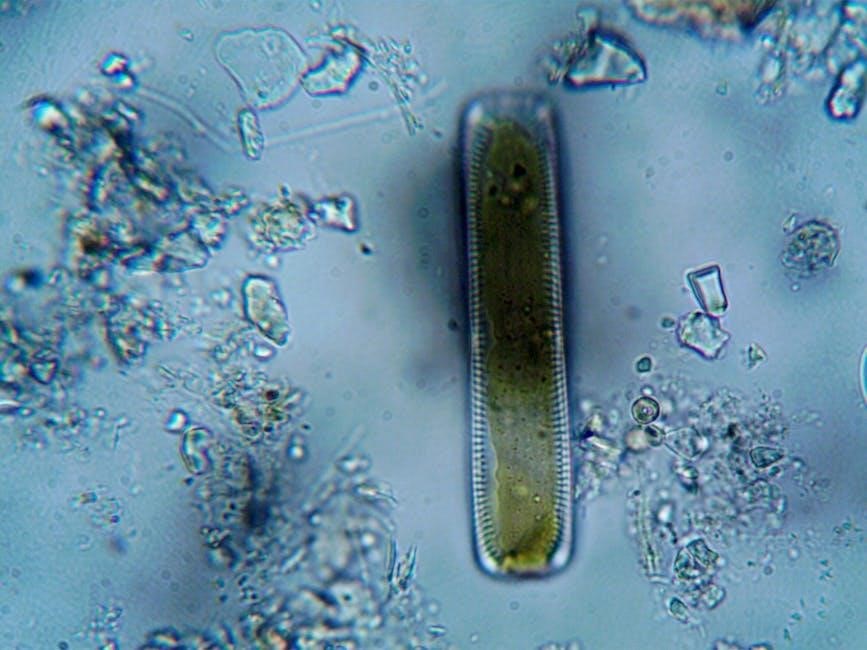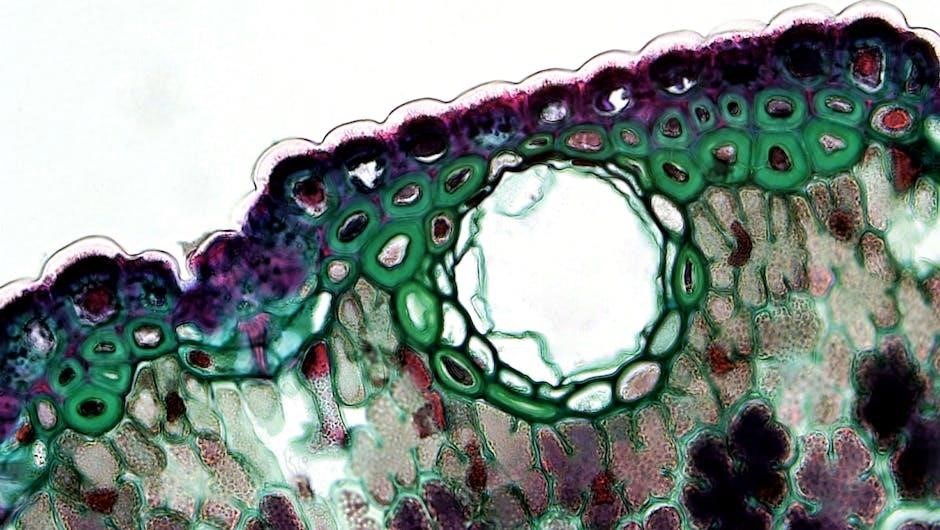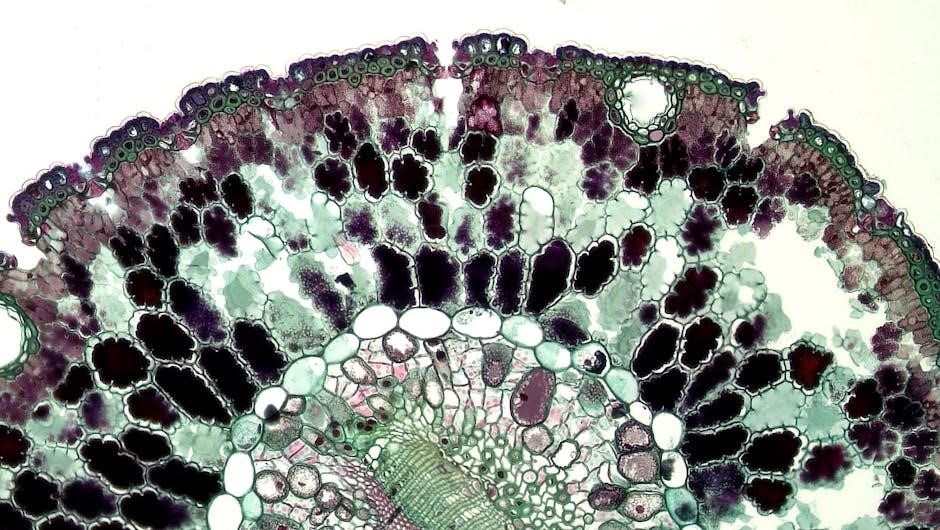Photosynthesis and cellular respiration are essential biological processes that sustain life on Earth. Photosynthesis converts sunlight into energy, while cellular respiration releases energy from food, forming a vital cycle.
1.1 Overview of Photosynthesis
Photosynthesis is a vital process where plants, algae, and some bacteria convert sunlight, carbon dioxide, and water into glucose and oxygen. This biochemical pathway occurs in chloroplasts and involves light-dependent and light-independent reactions. The light-dependent reactions capture solar energy, while the Calvin Cycle (light-independent) fixes carbon dioxide into sugars. Photosynthesis is essential for producing oxygen and organic molecules, supporting life on Earth. Factors like light intensity, temperature, and chlorophyll availability influence its efficiency. Understanding this process is crucial for studying ecosystems, plant growth, and energy production. It forms the foundation of food chains and energy flow in nature.
1.2 Overview of Cellular Respiration

Cellular respiration is a metabolic process that converts glucose and oxygen into energy (ATP), carbon dioxide, and water. It occurs in cells and is essential for energy production in all living organisms. The process involves aerobic respiration, which requires oxygen and is highly efficient, and anaerobic respiration, which does not use oxygen and is less efficient. Cellular respiration is vital for sustaining life, as it powers cellular functions, growth, and reproduction. Understanding this process is fundamental for studying energy transformation, metabolic pathways, and the interdependence of living systems. It complements photosynthesis by utilizing the products of that process.
1.3 Importance of Studying Both Processes
Studying photosynthesis and cellular respiration is crucial for understanding the flow of energy and matter in ecosystems. These processes are interconnected, with photosynthesis producing oxygen and glucose, which are then used in cellular respiration. Together, they form the foundation of life, enabling energy transfer and carbon cycling. Understanding these processes helps explain how organisms survive, grow, and interact with their environment. Additionally, studying both provides insights into practical applications, such as improving crop yields, combating climate change, and developing sustainable energy solutions. This knowledge is essential for advancing biology, ecology, and environmental science, making it a cornerstone of scientific literacy.

Photosynthesis
Photosynthesis is a vital process where plants, algae, and some bacteria convert sunlight, carbon dioxide, and water into glucose and oxygen. It occurs in chloroplasts and is essential for energy storage in ecosystems.
2.1 Definition and Basic Equation
Photosynthesis is the process by which plants, algae, and some bacteria convert sunlight, carbon dioxide, and water into glucose and oxygen. The basic equation is:
6CO₂ + 6H₂O + light → C₆H₁₂O₆ + 6O₂
This equation summarizes how energy from light is stored in glucose, which is used by plants and other organisms for energy. The process occurs in chloroplasts and involves two main stages: the light-dependent reactions and the Calvin Cycle. Understanding this equation is fundamental to grasping the mechanism of photosynthesis and its role in ecosystems.
2.2 Light-Dependent Reactions
The light-dependent reactions occur in the thylakoid membranes of chloroplasts. These reactions require direct light and involve two key steps: excitation of chlorophyll and water splitting. Chlorophyll absorbs light energy, transferring it to electrons, which are then passed through a series of molecules, forming ATP and NADPH. Simultaneously, water molecules are split, releasing oxygen as a byproduct. These reactions are crucial as they convert light energy into chemical energy, providing the ATP and NADPH needed for the Calvin Cycle. The process is highly dependent on light intensity and wavelength, with chlorophyll absorbing primarily blue and red light.
2.3 Light-Independent Reactions (Calvin Cycle)
The light-independent reactions, known as the Calvin Cycle, occur in the stroma of chloroplasts and do not require light. This process fixes carbon dioxide into glucose using the ATP and NADPH produced in the light-dependent reactions. The cycle has two phases: carbon fixation and reduction. In carbon fixation, CO2 is attached to RuBP (a 5-carbon molecule), forming a 6-carbon intermediate. This is then reduced to form two 3-carbon molecules (PGA), which are converted into glucose using ATP and NADPH. The cycle regenerates RuBP to maintain continuity. The enzyme RuBisCO catalyzes carbon fixation, making it a critical component of photosynthesis. This cycle is essential for producing organic molecules that sustain life.
2.4 Factors Affecting Photosynthesis
Photosynthesis is influenced by several factors, including light intensity, carbon dioxide concentration, temperature, and the availability of chlorophyll. Light intensity directly affects the rate of photosynthesis, with higher intensities generally increasing the rate up to a point. Carbon dioxide concentration is also critical, as it is a reactant in the Calvin Cycle. Temperature impacts enzyme activity, with optimal ranges varying by species. Additionally, the presence of chlorophyll and other pigments determines light absorption efficiency. Water availability, pH levels, and the presence of minerals like nitrogen and magnesium also play roles in regulating photosynthesis. Understanding these factors is key to optimizing plant growth and productivity.

Cellular Respiration
Cellular respiration is a chemical process breaking down food molecules and oxygen to produce energy, primarily in the form of ATP. Essential for all living organisms, it occurs in cells through aerobic or anaerobic pathways.
3.1 Definition and Basic Equation
Cellular respiration is a metabolic process in which cells break down glucose and oxygen to produce energy in the form of ATP. It involves three main stages: glycolysis, the Krebs cycle, and oxidative phosphorylation. The overall equation is:
C6H12O6 + 6O2 → 6CO2 + 6H2O + ATP (energy). This process is vital for energy production in all living organisms, converting biochemical energy into a usable form. It is a critical counterpart to photosynthesis, sustaining life by releasing stored energy.
3.2 Aerobic Respiration
Aerobic respiration is a process that requires oxygen to generate energy from glucose. It occurs in three stages: glycolysis, the Krebs cycle, and oxidative phosphorylation. Glycolysis breaks down glucose into pyruvate in the cytoplasm, producing a small amount of ATP. The Krebs cycle and oxidative phosphorylation take place in the mitochondria, where oxygen acts as the final electron acceptor, enabling the production of a large amount of ATP. This process is highly efficient, producing 36-38 ATP molecules per glucose molecule, making it a critical energy source for aerobic organisms.
3.3 Anaerobic Respiration
Anaerobic respiration occurs without oxygen and is less efficient than aerobic respiration. It takes place in the cytoplasm and involves the breakdown of glucose to produce ATP. In animals, this process results in the formation of lactic acid, while in yeast, it produces ethanol and carbon dioxide. Unlike aerobic respiration, anaerobic respiration does not require mitochondria and yields only 2 ATP molecules per glucose molecule. Despite its lower efficiency, anaerobic respiration is vital for providing energy during intense, short-duration activities when oxygen supply is limited. It also plays a role in fermentation processes, highlighting its importance in both biology and industry.
3.4 Factors Affecting Cellular Respiration
Cellular respiration is influenced by several factors, including oxygen availability, temperature, and enzyme activity. Oxygen levels determine whether aerobic or anaerobic respiration occurs, with oxygen increasing ATP production. Temperature affects enzyme efficiency, with optimal temperatures enhancing reaction rates, while extreme temperatures can denature enzymes. The availability of glucose and other substrates also impacts the process, as respiration depends on these energy sources. Additionally, the presence of inhibitors or uncouplers can disrupt specific steps in the pathway, altering ATP production. Understanding these factors is crucial for appreciating how cells adapt to varying conditions to maintain energy production.

Connection Between Photosynthesis and Cellular Respiration
Photosynthesis and cellular respiration are interdependent processes, with photosynthesis producing oxygen and glucose, while cellular respiration uses these to release energy, sustaining life’s energy cycle.
4.1 Energy Flow in Ecosystems
Energy flows through ecosystems via the processes of photosynthesis and cellular respiration. Photosynthesis captures sunlight, converting it into chemical energy stored in glucose. This energy is transferred to herbivores through consumption, and further to carnivores, forming a food chain. Cellular respiration releases energy from glucose, returning carbon dioxide to the atmosphere. Decomposers break down organic matter, recycling nutrients back to producers. This continuous cycle ensures energy is cycled efficiently, sustaining life in ecosystems. The interplay between these processes highlights the fundamental connection between energy production and consumption, maintaining ecological balance and supporting biodiversity.
4.2 Carbon Cycle and Oxygen Exchange

Photosynthesis and cellular respiration drive the carbon cycle and oxygen exchange. Photosynthesis absorbs carbon dioxide (CO2) from the atmosphere, converting it into glucose and releasing oxygen (O2). Conversely, cellular respiration breaks down glucose, releasing CO2 and consuming O2. This continuous exchange sustains life, as plants provide oxygen for animals, and animals release carbon dioxide for plants. The cycle maintains atmospheric gas balance, enabling ecosystems to function. Oxygen is vital for aerobic respiration, while carbon dioxide fuels photosynthesis, illustrating their interdependence. This exchange supports energy transfer and nutrient recycling, forming the backbone of life on Earth.
4.3 Importance of the Relationship
The relationship between photosynthesis and cellular respiration is vital for sustaining life on Earth. Photosynthesis provides the oxygen necessary for cellular respiration, while cellular respiration produces the carbon dioxide required for photosynthesis. This interdependence creates a balanced cycle of energy and resource exchange, enabling ecosystems to function. The processes support food chains, as plants provide energy for herbivores, which in turn sustain carnivores. Without this relationship, life as we know it would cease to exist. It underpins biodiversity, energy flow, and nutrient recycling, making it foundational for understanding how life thrives and interacts on our planet.

Practical Applications and Experiments
Practical experiments, such as measuring oxygen production in aquatic plants or using pH indicators, help visualize photosynthesis and cellular respiration. These hands-on activities enhance understanding of energy cycles.
5.1 Measuring Photosynthesis Rates
Measuring photosynthesis rates involves tracking oxygen production or carbon dioxide absorption. Common methods include using aquatic plants or algae in controlled environments. Tools like oxygen gas sensors or bubble counting devices are effective. Variables such as light intensity, temperature, and CO2 levels can be manipulated to observe their impact. For example, placing plants under different light sources or varying water temperatures. These experiments help quantify how environmental factors influence photosynthesis efficiency. Additionally, pH indicators can visually demonstrate the process by showing changes in water chemistry. Such practical investigations provide hands-on insights into the dynamics of photosynthesis, making complex concepts more accessible for students.
5.2 Measuring Cellular Respiration Rates
Measuring cellular respiration rates typically involves assessing carbon dioxide release or oxygen consumption. Techniques include using respirometers or gas sensors to quantify these outputs. Experiments often involve organisms like seeds, insects, or small animals. Variables such as temperature, oxygen availability, and substrate type can be manipulated to observe their effects. For instance, germinating seeds or exercising organisms show higher respiration rates. Data loggers and software can record real-time measurements, aiding in precise calculations. These experiments help students understand how environmental factors influence cellular energy production, bridging theoretical concepts with practical observations.
5.3 Investigating the Effects of Light on Photosynthesis
Light is a critical factor in photosynthesis, and its intensity, wavelength, and duration significantly impact the process. Experiments often involve measuring oxygen production or carbon dioxide absorption under varying light conditions. For example, algae or aquatic plants can be used to observe how light intensity affects photosynthesis rates. Tools like oxygen probes or pH indicators provide visual feedback, showing how light influences photosynthetic activity. Such investigations help students understand the role of light in energy conversion and its implications for plant growth and ecological balance, making these experiments both educational and engaging for studying photosynthesis dynamics.

Study Tips and Resources
Use NCERT textbooks and MTG NCERT At Your Fingertips for concise revision. Focus on active recall and practice questions to reinforce concepts. Teaching others also enhances understanding.
6.1 Key Concepts to Focus On
Focus on understanding the light-dependent and light-independent reactions in photosynthesis, including the Calvin Cycle. For cellular respiration, grasp aerobic and anaerobic processes, emphasizing the role of ATP. Study the interdependence of photosynthesis and respiration, such as oxygen and carbon dioxide exchange. Pay attention to factors affecting both processes, like light intensity, temperature, and CO2 levels. Understand the role of chloroplasts and mitochondria as key organelles. Practice balancing chemical equations and identifying the stages of each process. Familiarize yourself with practical experiments, such as measuring oxygen production or carbon dioxide absorption, to reinforce theoretical knowledge.
6.2 Recommended Study Materials
Utilize NCERT textbooks for a foundational understanding of photosynthesis and cellular respiration. Supplements like MTG’s NCERT At Your Fingertips provide concise revision notes. Online platforms such as Khan Academy and Crash Course offer engaging video explanations. Lab simulations, like those from PhET or Virtual Labs, allow interactive exploration of processes. Additionally, research papers on diagnostic question clusters and study guides like Photosynthesis and Respiration: A Study Guide can deepen understanding. Lastly, flashcards and concept maps are excellent tools for active recall of key terms and processes.
6.3 Effective Note-Taking Strategies
Adopt the Cornell Method to organize notes into sections for cues, summaries, and main content. Highlight key terms like photosynthesis and cellular respiration for quick reference. Use bullet points and color-coding to differentiate processes, such as light-dependent reactions versus the Calvin Cycle. Incorporate diagrams to visualize complex pathways like the electron transport chain. Practice active recall by testing yourself on definitions and equations without notes. Finally, review and condense notes weekly, summarizing concepts in your own words to reinforce understanding and retention.

Common Misconceptions
Many believe photosynthesis occurs only in leaves and that plants don’t respire, but respiration is vital for plant energy, and stems can photosynthesize too.
7.1 Misconceptions About Photosynthesis
A common misconception is that photosynthesis occurs only in leaves, but stems can also photosynthesize. Many believe plants don’t respire, but respiration is essential for their energy needs. Others think photosynthesis requires direct sunlight, neglecting its occurrence in low-light conditions. Some mistakenly assume only green parts photosynthesize, ignoring the role of other pigments. Another myth is that photosynthesis produces unlimited oxygen, while in reality, it depends on environmental factors. Clarifying these misunderstandings helps build a stronger foundation for studying the process. These misconceptions highlight the importance of detailed study to grasp the complexity of photosynthesis accurately.
7.2 Misconceptions About Cellular Respiration
One common misconception is that cellular respiration occurs only in animals, but it is a universal process in all living cells. Many believe it happens exclusively in the mitochondria, though it begins in the cytoplasm. Some think oxygen is always required, but anaerobic respiration proves otherwise. Another myth is that cellular respiration is a single, fast step, while it involves multiple complex stages. Additionally, people often overlook the role of carbon dioxide as a byproduct, focusing only on oxygen. Clarifying these misconceptions helps in understanding the process accurately and appreciating its critical role in energy production for all life forms.

Visual Aids for Better Understanding
Visual aids like diagrams, flowcharts, and infographics simplify complex processes. They help illustrate the stages of photosynthesis and cellular respiration, making abstract concepts more tangible and engaging for learners.
8.1 Diagrams of Photosynthesis
Diagrams of photosynthesis are invaluable for visualizing the process. They illustrate the transformation of light energy into chemical energy, showing the light-dependent reactions and Calvin Cycle. These diagrams often depict the chloroplast structure, highlighting the thylakoid membranes and stroma. Arrows and labels clarify the flow of energy and molecules like ATP, NADPH, and CO2. Such visuals help learners understand how plants produce glucose and oxygen, making the abstract process tangible. They also emphasize the cyclical nature of energy conversion, linking light absorption to sugar synthesis. Detailed diagrams can include electron transport chains and the role of chlorophyll, enhancing comprehension of this complex biochemical pathway.
8.2 Diagrams of Cellular Respiration
Diagrams of cellular respiration visually represent the process of converting glucose into energy. They often depict the three main stages: glycolysis, the Krebs cycle, and the electron transport chain. These diagrams show how glucose breaks down into pyruvate, then into acetyl-CoA, and finally into carbon dioxide, releasing energy at each step. Arrows illustrate the flow of molecules like ATP, NADH, and oxygen, highlighting their roles. The diagrams also clarify the locations of each stage within the cell, such as glycolysis in the cytosol and the Krebs cycle in the mitochondria. They effectively demonstrate how cells generate energy efficiently, linking aerobic and anaerobic pathways.
